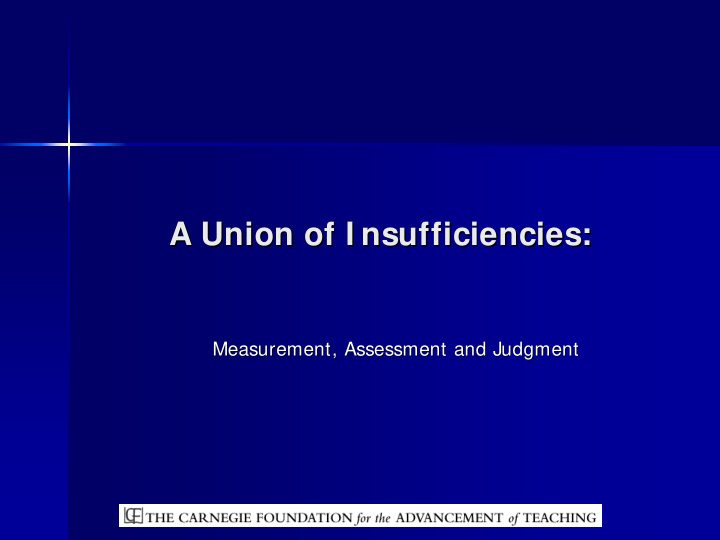



A Union of I nsufficiencies: A Union of I nsufficiencies: Measurement, Assessment and Judgment Measurement, Assessment and Judgment
1948: Meeting of College Examiners at 1948: Meeting of College Examiners at American Psychological Association American Psychological Association Benjamin Bloom Benjamin Bloom Need for a shared lexicon and conceptual Need for a shared lexicon and conceptual framework for the evaluation of framework for the evaluation of undergraduate general education undergraduate general education
Bloom et al Taxonomies Cognitive Affective Knowledge Receiving Comprehension Responding Application Valuing Analysis Organizing Synthesis Internalizing Evaluation
Four Questions Four Questions � Admissions: whom do we teach in what Admissions: whom do we teach in what � kinds of institutions? kinds of institutions? � Accountability: how well do they learn what Accountability: how well do they learn what � is most worth learning? is most worth learning? � National comparisons: how well do we National comparisons: how well do we � compete? compete? � Teacher Quality: What kinds of teachers are Teacher Quality: What kinds of teachers are � most competent to teach what is most most competent to teach what is most worth learning? worth learning?
Shared underlying questions Shared underlying questions What knowledge is most worth? What knowledge is most worth? What knowledge is most What knowledge is most worth… …learning? learning? worth What knowledge is most What knowledge is most worth… …assessing? assessing? worth e.g., TIMSS and PISA; GRE, CLA, ACT Comp e.g., TIMSS and PISA; GRE, CLA, ACT Comp
Shavelson and Huang’ ’s Model of Ability and Achievement s Model of Ability and Achievement Shavelson and Huang
Professional Learning Professional Learning (with implications for liberal learning) (with implications for liberal learning) Habits of Mind Habits of Mind � � Habits of Practice (hand) � Habits of Practice (hand) � Habits of the Heart � Habits of the Heart � Generally assessed by visible, public performances of Generally assessed by visible, public performances of understanding, skill and disposition either embedded in understanding, skill and disposition either embedded in the course of instruction/residencies or as the course of instruction/residencies or as “ “signature signature performances” ” performances
Thought experiments: Thought experiments: Unions of insufficiency Unions of insufficiency � Selecting a spouse or partner Selecting a spouse or partner � � Buying a car Buying a car � � Judging the health of the economy Judging the health of the economy � � Evaluating an athlete Evaluating an athlete � � Evaluating marriages or families Evaluating marriages or families � � Evaluating priests, ministers and rabbis Evaluating priests, ministers and rabbis � � Making a legal decision in an appeals court Making a legal decision in an appeals court � Models of practical arguments: uses of indicators Models of practical arguments: uses of indicators (premises) in the service of decisions and action (premises) in the service of decisions and action
The truncation of Merit… … The truncation of Merit Broadening the indicators Broadening the indicators And Method… … And Method the persistent mystery of method variance the persistent mystery of method variance (Heisenberg meets Campbell & Fiske) (Heisenberg meets Campbell & Fiske)
Five Principles Five Principles � Error of the single instrument: Designed Error of the single instrument: Designed � insufficiency insufficiency � Multiple indicators: Unions of insufficiency Multiple indicators: Unions of insufficiency � � Aggregating for validity: Transparent policies of Aggregating for validity: Transparent policies of � aggregation (Shavelson’ aggregation (Shavelson ’ challenge) challenge) � High stakes/low yield High stakes/low yield must give way to must give way to Low Low � stakes/high yield : Timing, embedding, coaching and : Timing, embedding, coaching and stakes/high yield repeating repeating � Resistance to corruption: Educative assessments Resistance to corruption: Educative assessments �
A Theory of Action: A Theory of Action: What motivates faculty and institutions to What motivates faculty and institutions to take responsibility for the quality of take responsibility for the quality of education? education? � Mirrors Mirrors: Seeing your teaching and student learning : Seeing your teaching and student learning � (classroom research; scholarship of teaching and learning) (classroom research; scholarship of teaching and learning) � Lenses Lenses: See teaching and learning in new ways unavailable : See teaching and learning in new ways unavailable � simply by looking or documenting (NSSE; CLA; clinical simply by looking or documenting (NSSE; CLA; clinical interviews; comparing to standards) interviews; comparing to standards) � Windows Windows: See how your compare via windows and/or : See how your compare via windows and/or � lenses with your peers (NSSE comparisons; CLA lenses with your peers (NSSE comparisons; CLA comparisons; studying others’ ’ portfolios) portfolios) comparisons; studying others Reflection for action: Convene to consider data and explore : Convene to consider data and explore � � Reflection for action options (faculty inquiry groups; NBPTS support groups) options (faculty inquiry groups; NBPTS support groups)
The Future: Collapsing Distinctions The Future: Collapsing Distinctions Between formative and summative � Between formative and summative � Between high stakes and low stakes � Between high stakes and low stakes � Between lower and higher level understanding � Between lower and higher level understanding � Between cognitive, affective and formational � Between cognitive, affective and formational � Reversing the validity argument: where’ ’s the s the critieron critieron? ? � Reversing the validity argument: where � ---------------------------------------------------- ---------------------------------------------------- Practices of classroom research and the scholarship of teaching Practices of classroom research and the scholarship of teaching and learning and learning Trust in the judgments of educators Trust in the judgments of educators Invent a next- -generation psychometric theory and practice generation psychometric theory and practice Invent a next
� Have a nice day Have a nice day… …and a fine century! and a fine century! � – (attributed to Bond, 2006) (attributed to Bond, 2006) –
Recommend
More recommend